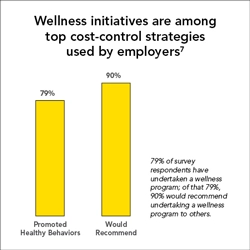Why Fruit at Work?
A FruitGuys White Paper
Wellness Works
In 2011, a majority of U.S. companies with 50 to 1,000 employees reported that the wellness programs they offered met or exceeded expectations in reducing overall health care costs.¹
 These companies found that “wellness programs are one of the best ways for employers to promote a healthy workforce, contain rising healthcare expenses, and improve productivity among their employees.” The majority of these companies also reported their wellness programs met or exceeded senior executives’ expectations in regards to reducing overall healthcare costs, and found that wellness programs increased productivity without negative impacts on employee morale.²
These companies found that “wellness programs are one of the best ways for employers to promote a healthy workforce, contain rising healthcare expenses, and improve productivity among their employees.” The majority of these companies also reported their wellness programs met or exceeded senior executives’ expectations in regards to reducing overall healthcare costs, and found that wellness programs increased productivity without negative impacts on employee morale.²
300% ROI
More than 30 years of evidence has shown that every $1 invested in a workplace wellness program returns at least $3.27.³ And ROI can be even higher: a 2010 study found employer savings on health insurance as high as $6 for every $1 invested in wellness.4 In addition, a Harvard University analysis found absenteeism costs falling by about $2.73 for every dollar spent on wellness programs.5
It’s no surprise that there is growing interest in workplace health and wellness programs. Wellness initiatives work, with tangible results measured in:
- Fewer sick days.
- Increased productivity.
- More positive work environment.
- Greater employee engagement.
- Higher employee retention rate due to improved morale.
- Reduced occurrences of preventable chronic conditions.6

Office Fruit and Wellness
The FruitGuys deliveries of nutritious fresh fruit are a crucial component of thousands of workplace wellness programs with benefits for employee health and morale that extend beyond the workplace to make healthier lives. Fruit and vegetable intake is one of the most important aspects of diet for disease prevention;8 greater consumption of fruits and vegetables is associated with a reduced risk of cardiovascular disease, stroke, certain types of cancer, and type 2 diabetes, as well as improved weight management.9
The majority of American adults fall significantly short of the recommended amount of fruit every day. However, “worksites offer a unique opportunity to address unhealthful dietary practices, with access to 65% of adults, many of whom spend a majority of their waking hours on the job10.
And workers welcome healthy snacks in the office. In a 2011 survey of U.S. office workers at nearly 200 businesses of all sizes, more than 85% said they want healthy snacks and beverages added to their office kitchen and 73% said that a well-stocked kitchen would make them happier at work. The office kitchen was viewed by 72% as more than just a place to get coffee—it represents a place to get work done through impromptu meetings and a place that helps them keep energy levels high.11
The FruitGuys Fruit Increases Wellness
For a 2011 research study funded by the Centers for Disease Control and the U.S. Department of Agriculture, The FruitGuys delivered fresh fruit to approximately 600 workers at nine office locations.
This study concluded that:
“Workers with access to fresh fruit at work showed a statistically significant increase in fruit, vegetable, and total fruit and vegetable consumption, and purchasing of fruit…The authors can attribute the significant increase of fruit consumption to the heightened availability and accessibility of fruit at the worksites…
The results of this study demonstrate that fresh fruit deliveries to offices and worksites significantly improve fruit and vegetable consumption and deliver commensurate chronic disease risk reduction benefits.
As business owners and worksite wellness professionals consider health promotion benefits for employees, the findings of this study may help inform future decisions about the role a fruit snack program could play as part of a comprehensive worksite wellness approach”12.
Amid soaring health spending and benefit costs, effective cost-containment strategies such as workplace wellness programs are readily available and proven to work.
Make The FruitGuys part of your wellness program.
Sources:
1 ADP Research Institute, Survey on Wellness, April, 2011.
2 Ibid.
3 Health Affairs, February 2010, vol. 29, no. 2.
4 Edington, D.W., et al. Health Management Research Center, University of Michigan, 2010 Cost-Benefit Analysis and Report, Workplace and Workforce Health and Wellness.
5 Health Affairs, February 2010, vol. 29, no. 2.
6 Edington, op.cit.
8 Knoops K, de Groot L, Kromhout D, et al. Journal of the American Medical Association, 2004.
9 McKee M. Bull. World Health Organ. 2005. Rolls BJ, Ello-Martin JA, Tohill BC. What can intervention studies tell us about the relationship between fruit and vegetable consumption and weight management? Nutr Rev. 2004. World Cancer Research Fund/American Institute for Cancer Research. Food, Nutrition, Physical Activity, and the Prevention of Cancer: A Global Perspective, AICR; 2007.
10 Desiree Backman, DrPH, et al. Journal of Nutrition Education and Behavior, Volume 43, 2011.
11 PlanSponsor.com, survey of 200 U.S. businesses of all sizes, April, 2011.
12 Journal of Nutrition Education and Behavior, Volume 43, 2011.


